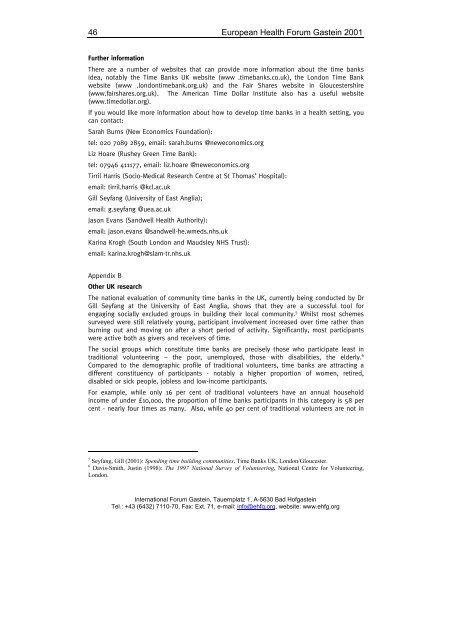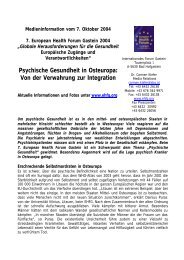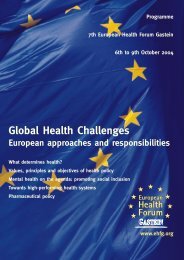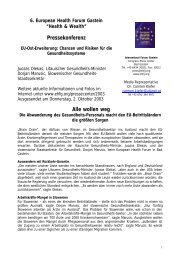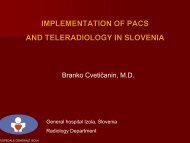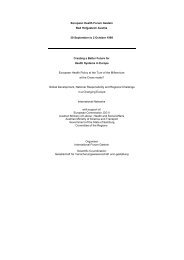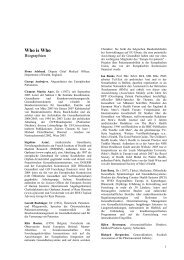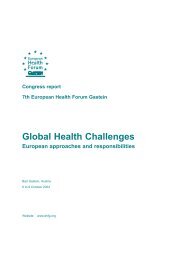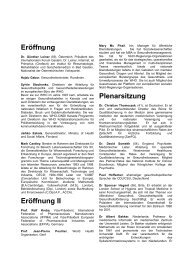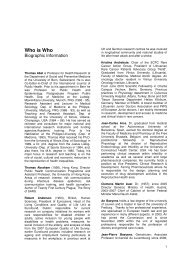Congress report - European Health Forum Gastein
Congress report - European Health Forum Gastein
Congress report - European Health Forum Gastein
Create successful ePaper yourself
Turn your PDF publications into a flip-book with our unique Google optimized e-Paper software.
46<br />
<strong>European</strong> <strong>Health</strong> <strong>Forum</strong> <strong>Gastein</strong> 2001<br />
Further information<br />
There are a number of websites that can provide more information about the time banks<br />
idea, notably the Time Banks UK website (www .timebanks.co.uk), the London Time Bank<br />
website (www .londontimebank.org.uk) and the Fair Shares website in Gloucestershire<br />
(www.fairshares.org.uk). The American Time Dollar Institute also has a useful website<br />
(www.timedollar.org).<br />
If you would like more information about how to develop time banks in a health setting, you<br />
can contact:<br />
Sarah Burns (New Economics Foundation):<br />
tel: 020 7089 2859, email: sarah.burns @neweconomics.org<br />
Liz Hoare (Rushey Green Time Bank):<br />
tel: 07946 411177, email: liz.hoare @neweconomics.org<br />
Tirril Harris (Socio-Medical Research Centre at St Thomas’ Hospital):<br />
email: tirril.harris @kcl.ac.uk<br />
Gill Seyfang (University of East Anglia);<br />
email: g.seyfang @uea.ac.uk<br />
Jason Evans (Sandwell <strong>Health</strong> Authority):<br />
email: jason.evans @sandwell-he.wmeds.nhs.uk<br />
Karina Krogh (South London and Maudsley NHS Trust):<br />
email: karina.krogh@slam-tr.nhs.uk<br />
Appendix B<br />
Other UK research<br />
The national evaluation of community time banks in the UK, currently being conducted by Dr<br />
Gill Seyfang at the University of East Anglia, shows that they are a successful tool for<br />
engaging socially excluded groups in building their local community. 5 Whilst most schemes<br />
surveyed were still relatively young, participant involvement increased over time rather than<br />
burning out and moving on after a short period of activity. Significantly, most participants<br />
were active both as givers and receivers of time.<br />
The social groups which constitute time banks are precisely those who participate least in<br />
traditional volunteering – the poor, unemployed, those with disabilities, the elderly. 6<br />
Compared to the demographic profile of traditional volunteers, time banks are attracting a<br />
different constituency of participants - notably a higher proportion of women, retired,<br />
disabled or sick people, jobless and low-income participants.<br />
For example, while only 16 per cent of traditional volunteers have an annual household<br />
income of under £10,000, the proportion of time banks participants in this category is 58 per<br />
cent - nearly four times as many. Also, while 40 per cent of traditional volunteers are not in<br />
5<br />
Seyfang, Gill (2001): Spending time building communities, Time Banks UK, London/Gloucester.<br />
6<br />
Davis-Smith, Justin (1998): The 1997 National Survey of Volunteering, National Centre for Volunteering,<br />
London.<br />
International <strong>Forum</strong> <strong>Gastein</strong>, Tauernplatz 1, A-5630 Bad Hofgastein<br />
Tel.: +43 (6432) 7110-70, Fax: Ext. 71, e-mail: info@ehfg.org, website: www.ehfg.org


